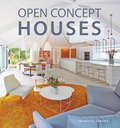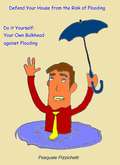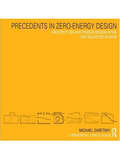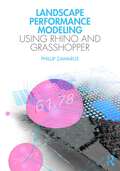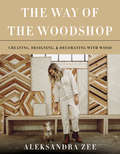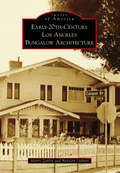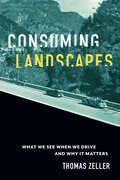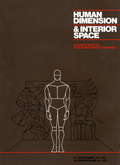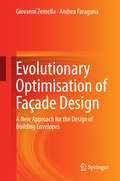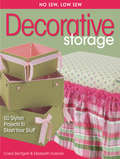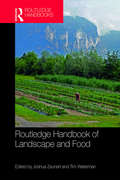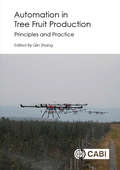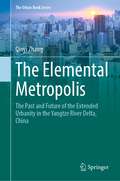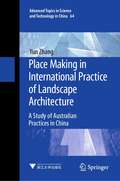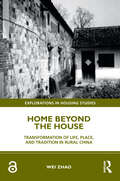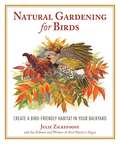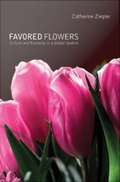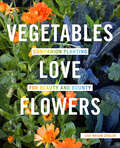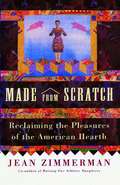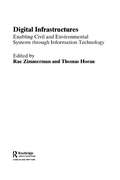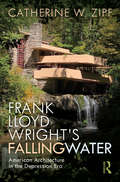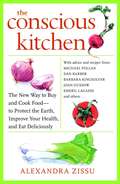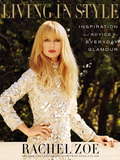- Table View
- List View
Open Concept Houses
by Francesc ZamoraFrom the author of the successful 150 Best series comes the debut entry in the forward-thinking Open Concept Houses series, filled with nearly 500 pages of color photos—sure to become the ultimate resource for this fast-growing trend in home design and renovation.One of the hottest lifestyle trends today, open concept living spaces eliminate doorways and walls to create a large combined area for cooking, dining, entertaining, and relaxing. No longer are the kitchen, dining room, and living room compartmentalized. Instead, each space blends into the next to create one large area "separated" and defined by islands, carpets, and furniture. This increasingly popular style provides a sense of expansiveness, connectedness, and flow that traditional architecture and design—defined by spaces broken by walls—lack.This engaging, inspiring, and informative volume brings together a diverse collection of houses from all over the world, including spaces that have been designed from the ground up or have been renovated to reflect this popular trend. Inside Open Concept Houses you’ll find an array of beautiful and creative homes by distinguished international architects and designers who have conceived practical and functional solutions adapted to the specific needs and particular tastes of their clients.Filled with hundreds of full-color photographs as well as sets of floorplans for renovated residences—both the original and remodeled blueprints—this imaginative, idea-filled book is a must-have for architects, designers, decorators, and home owners looking to create or adapt the open concept style in their own dwellings.
Defend your house from the risk of flooding - Do it yourself: your own bulkhead against flooding
by Silvia Dalla Zanna Pasquale PizzichettiSome say that the danger posed by water is worse than that of fire. In effect I fear both. However, either if you live in a city or in a provincial town, there is always a risk, higher or lower, to be flooded by water. For those who do not want to suffer passively the events, here is a practical guide to build "Do it yourself" bulkheads against flooding. With some good will and time, you can build a low cost efficient system with simple materials. This guide is intended for everybody, but in particular for people who are not professional in this field.
Precedents in Zero-Energy Design: Architecture and Passive Design in the 2007 Solar Decathlon
by Michael Zaretsky‘Michael Zaretsky’s Precedents in Zero-Energy Design is such an important book … it will help readers recognize that design comes before technology – and renewable energy systems alone can’t solve the problems we face’ – John D. Quale, Assistant Professor of Architecture and ecoMOD Project Director, University of Virginia The world is currently facing an environmental crisis and as anyone interested in sustainable or zero-energy design knows the design and building industries have the potential to significantly reduce greenhouse gas emissions across the globe. The Solar Decathlon is an international event in which universities from around the world compete in the design and construction of a one-bedroom, zero-energy house. This book provides an in-depth, yet accessible analysis of the architecture and passive design strategies of the houses in the 2007 Solar Decathlon. These houses are the result of thousands of hours of research and development from twenty universities around the world. Divided into three parts, the book provides: an initial section investigating the architecture, passive design and systems layout of the twenty houses; a diagrammatic comparison of the architecture and passive design characteristics of each of the twenty houses in order of ranking by the Architecture, Comfort Zone and overall scores received in the competition; a deep analysis of the relationship between architecture, passive design and mechanical systems design as compared to the rankings received in the various contests. This analysis considers the decisions made by the competing teams and highlights the success of the design strategies employed. Students, educators, practitioners and researchers of architecture, design and engineering will find this an informative and inspirational book. It examines the relationship between design and environmental principles and provides invaluable insight into some of the most innovative, off-the-grid and zero-energy houses in the world. With a Foreword by John D. Quale, Assistant Professor of Architecture and ecoMOD Project Director, University of Virginia
Landscape Performance Modeling Using Rhino and Grasshopper
by Phillip ZawarusThis is a guidebook for landscape architects to learn the fundamental practices and use of the computational software Rhino 3D and the plugin Grasshopper for parametric modeling, landscape inventory, and performative analysis. This process visually connects intangible and abstract information with physical and spatial relationships to signify the impact ecological, climate, and cultural factors have on landscape performance and decision making. Each chapter begins with a summary of the performance method and its application in different projects, outlining the expected goals from industry standard equations and operations. Chapters cover parametric modeling scripts to measure ecosystem services of stormwater management, erosion control, tree benefits, outdoor comfort, accessibility, and many others. Using photographs, tables, and parametric scripts to create qualitative and quantitative representations of landscape performance and ecosystem services, readers will learn to communicate the impact and significance of their outputs. This book will be beneficial to educators, students, and professionals interested in using computational modeling as a performance assessment and graphic visualization tool.
The Way of the Woodshop: Creating, Designing & Decorating with Wood
by Aleksandra ZeeShop Class as Soulcraft meets Norwegian Wood in this gorgeously illustrated DIY guide for aspiring woodworkers of all levels.“There’s just something about wood. It’s an imperfect material with cracks, knots, and irregularities. As an imperfect being, I find that by working with wood and all its inconsistencies, I can also tackle my own.” –Aleksandra ZeeRoll up your sleeves and get ready to master the basics of woodworking in Aleksandra Zee’s cozy Bay Area studio. The Way of the Woodshop is a meditative guidebook and a feast for the eyes, an illustrated journey through the joys of working, decorating, and crafting with wood. Packed with gorgeous photography and do-it-yourself projects ranging from easy to advanced, The Way of the Woodshop takes you step by step through the process of creating nesting cutting boards, a blanket ladder, a daybed, a table and bench, and more. Zee covers the basics, from choosing the right lumber, to understanding different wood types and grains, to curating a tool collection, along with tips on decorating with wood and curating a space that you love. Along the way, she encourages you to tap into your creativity and relish the joys of working with your hands, and she shares lessons from her own empowering journey, as a woman carving out her space in a stereotypically male profession.Whether you want to decorate your home, create personal gifts, or just love handmade objects, The Way of the Woodshop will inspire you to grab a sander and discover the joy of making!
Early-20th-Century Los Angeles Bungalow Architecture (Images of America)
by Harry Zeitlin Bennett GilbertLos Angeles, California, shaped the nation's culture in the 20th century with the city's bungalow style of mass middle-class housing. The style made the novelty and easy climate of Los Angeles into a force for living according to new standards of health and well-being, freedom and openness, and simple artistry. The bungalow combined the cozy appeal of Arts and Crafts design with what became the basic principles of 20th-century house architecture: earth-hugging lines, visible structure, and open floor plans emphasizing warmth, intimacy, and fluidity. While the streets and neighborhoods of the "bungalowtown" presented a lively panorama in which each house stood out as an individual, the bungalow was also a dream that the real estate industry sold to exploit the hunger for upward mobility that brought hundreds of thousands of new residents to the city during the three decades of the popularity of the style. Some of the neighborhoods that the developers established failed, and many homes were eventually demolished or in advanced decay. Yet today, these old houses are beautiful and comfortable homes when restored.
Consuming Landscapes: What We See When We Drive and Why It Matters
by Thomas ZellerWhat we see through our windshields reflects ideas about our national identity, consumerism, and infrastructure.For better or worse, windshields have become a major frame for viewing the nonhuman world. The view from the road is one of the main ways in which we experience our environments. These vistas are the result of deliberate historical forces, and humans have shaped them as they simultaneously sought to be transformed by them. In Consuming Landscapes, Thomas Zeller explores how what we see while driving reflects how we view our societies and ourselves, the role that consumerism plays in our infrastructure, and ideas about reshaping the environment in the twentieth century.Zeller breaks new ground by comparing the driving experience and the history of landscaped roads in the United States and Germany, two major automotive countries. He focuses specifically on the Blue Ridge Parkway in the United States and the German Alpine Road as case studies. When the automobile was still young, an early twentieth-century group of designers—landscape architects, civil engineers, and planners—sought to build scenic infrastructures, or roads that would immerse drivers in the landscapes that they were traversing. As more Americans and Europeans owned cars and drove them, however, they became less interested in enchanted views; safety became more important than beauty. Clashes between designers and drivers resulted in different visions of landscapes made for automobiles. As strange as it may seem to twenty-first-century readers, many professionals in the early twentieth century envisioned cars and roads, if properly managed, as saviors of the environment. Consuming Landscapes illustrates how the meaning of infrastructures changed as a result of use and consumption. Such changes indicate a deep ambivalence toward the automobile and roads, prompting the question: can cars and roads bring us closer to nature while deeply altering it at the same time?
Human Dimension and Interior Space
by Martin Zelnik Julius PaneroThe study of human body measurements on a comparative basis is known as anthropometrics. Its applicability to the design process is seen in the physical fit, or interface, between the human body and the various components of interior space.Human Dimension and Interior Space is the first major anthropometrically based reference book of design standards for use by all those involved with the physical planning and detailing of interiors, including interior designers, architects, furniture designers, builders, industrial designers, and students of design. The use of anthropometric data, although no substitute for good design or sound professional judgment should be viewed as one of the many tools required in the design process. This comprehensive overview of anthropometrics consists of three parts.The first part deals with the theory and application of anthropometrics and includes a special section dealing with physically disabled and elderly people. It provides the designer with the fundamentals of anthropometrics and a basic understanding of how interior design standards are established. The second part contains easy-to-read, illustrated anthropometric tables, which provide the most current data available on human body size, organized by age and percentile groupings. Also included is data relative to the range of joint motion and body sizes of children. The third part contains hundreds of dimensioned drawings, illustrating in plan and section the proper anthropometrically based relationship between user and space. The types of spaces range from residential and commercial to recreational and institutional, and all dimensions include metric conversions.In the Epilogue, the authors challenge the interior design profession, the building industry, and the furniture manufacturer to seriously explore the problem of adjustability in design. They expose the fallacy of designing to accommodate the so-called average man, who, in fact, does not exist. Using government data, including studies prepared by Dr. Howard Stoudt, Dr. Albert Damon, and Dr. Ross McFarland, formerly of the Harvard School of Public Health, and Jean Roberts of the U.S. Public Health Service, Panero and Zelnik have devised a system of interior design reference standards, easily understood through a series of charts and situation drawings. With Human Dimension and Interior Space, these standards are now accessible to all designers of interior environments.
Evolutionary Optimisation of Façade Design
by Giovanni Zemella Andrea FaragunaOptimization techniques offer immense potential for the improvement of performance-driven design, since they allow the adoption of an holistic approach. This can lead to great advantages: optimal design solutions can be properly identified only if all criteria are considered at the same time, rather than separately. There are two barriers which obstruct optimization from being applied to building design: a technological barrier (applying the algorithms is not easy and can be quite time-consuming) and a cultural one (architects and engineers are required to change their perspectives as the design process has to be handled in a new way). This book explores these barriers from the perspective of both engineers and architects, and proposes a change in the attitudes of these two "actors": an engineer and an architect develop a dialog which helps them understand each other's perspective; in this way they find how they must both make a step forward.
No Sew, Low Sew Decorative Storage: 50 Stylish Projects to Stash Your Stuff
by Carol ZentgrafThe saying is true: you can never have too much storage. And now, creating beautiful hatboxes, shoe racks, baskets, and even tuffets and ottomans that can be used for storage, has never been easier. Many of these inexpensive projects can be completed with a hot glue gun, basic hand stitches, and other fast and easy techniques.No Sew, Low Sew Decorative Storage offers 40+ inexpensive and easy-to-make projects of all sizes that can be used throughout the house. Anyone with basic sewing or crafting skills can successfully follow the step-by-step instructions and 200 photos to success in organizing their entire household in beautiful style.
Routledge Handbook of Landscape and Food
by Joshua Zeunert Tim WatermanSince the turn of the millennium, there has been a burgeoning interest in, and literature of, both landscape studies and food studies. Landscape describes places as relationships and processes. Landscapes create people’s identities and guide their actions and their preferences, while at the same time are shaped by the actions and forces of people. Food, as currency, medium, and sustenance, is a fundamental part of those landscape relationships. This volume brings together over fifty contributors from around the world in forty profoundly interdisciplinary chapters. Chapter authors represent an astonishing range of disciplines, from agronomy, anthropology, archaeology, conservation, countryside management, cultural studies, ecology, ethics, geography, heritage studies, landscape architecture, landscape management and planning, literature, urban design and architecture. Both food studies and landscape studies defy comprehension from the perspective of a single discipline, and thus such a range is both necessary and enriching. The Routledge Handbook of Landscape and Food is intended as a first port of call for scholars and researchers seeking to undertake new work at the many intersections of landscape and food. Each chapter provides an authoritative overview, a broad range of pertinent readings and references, and seeks to identify areas where new research is needed—though these may also be identified in the many fertile areas in which subjects and chapters overlap within the book.
Automation in Tree Fruit Production: Principles and Practice
by Qin ZhangAutomation in agriculture is made possible by the integration of advanced agricultural technology and precision agriculture management. This book, uniquely, will focus on applications of automation to the important industry of tree fruit production. Written by experts in agricultural automation technology from around the world, chapters in this book cover topics such as automated tree fruit production systems, plant stress sensing and high-throughput phenotyping in precision horticulture, the economics of automation in tree fruit production, light interception sensing systems for canopy management, precision irrigation and water management, precision technologies for pest and disease management, opportunities for the application of robotics in tree fruit production, and the mechanical harvesting and handling of fruit crops. The book is a representative, concise overview of the variety of technologies currently being applied to tree fruit crops around the world and the challenges faced by engineers and farmers that these technologies raise. It is aimed at researchers and graduate students of agriculture systems, agricultural and biological engineering, crop and soil sciences, horticulture, precision agriculture, and other relevant disciplines. It will also be of use to agriculture consultants, engineers, and other professionals such as agricultural equipment manufacturers and management professionals who use precision agriculture technologies. Key Features: - Takes a systematic approach to how to apply precision and automation technologies to fruit production. - Combines the disciplines of economics, horticulture, and engineering. - Illustrated by case studies throughout describing actual applications of automation technology.
The Elemental Metropolis: The Past and Future of the Extended Urbanity in the Yangtze River Delta, China (The Urban Book Series)
by Qinyi ZhangThis book provides a multi-scale reading of the spatial “elements” in which the extensive urbanity in Yangtze River Delta is constructed, and from there an imagination of a new paradigm of urbanization. The urbanization in Yangtze River Delta today is in need of a new interpretation and paradigm. The delta is a territory with city cores but it also has vast dispersed urbanization where the agricultural and non-agricultural activities and spaces are mixed and interlinked, a desakota (McGee, 1991). This book attempts to answer a basic question: what is the desakota in the Yangtze River Delta made of? The research Horizontal Metropolis led by Prof. Paola Viganò at EPFL, Switzerland focuses on the form of the contemporary city – the fragmentary spatial condition and dispersed urbanity all over the world. The study on Yangtze River delta is part of its research frame.
Place Making in International Practice of Landscape Architecture: A Study of Australian Practices in China (Advanced Topics in Science and Technology in China #64)
by Yun ZhangThis book explores international practice in landscape architecture, focusing on the provision of services from Australia to China during China’s contemporary urbanization and Australian landscape architects’ approaches to place. Landscape architectural practice requires planners and designers to have a deep understanding of local culture, site characteristics, craftsmanship and even project procedures that are often intangible. How to acquire the above local knowledge has become a major challenge for international teams. Through the survey of the practice of Australian landscape practices in China and the case study of Li Lake planning and design project, this book reveals the process and difficulties of landscape planning and design as a transnational practice, as well as its special value as a way of cross-cultural fertilization. This book is intended for students, practitioners and researchers in the fields of landscape architecture, architecture and urban planning.
Home Beyond the House: Transformation of Life, Place, and Tradition in Rural China (Explorations in Housing Studies)
by Wei ZhaoBased on extended fieldwork conducted between 2007 and 2019, this book aims to answer a simple question: What is the meaning of home for people living in vernacular settlements in rural China? This question is particularly potent since rural China has experienced rapid and fundamental changes in the twenty-first century under the influences of national policies such as "Building a New Socialist Countryside" enacted in 2006 and "Rural Revitalization" announced in 2018. Drawing upon ethnographic fieldwork, building surveys, archival research, and over 600 photographs taken by residents along with their life stories, this book uncovers the meanings of home from rural residents’ perspectives, who belong to a social group that is underrepresented in scholarship and underserved in modern China. In other words, this study empowers rural residents by giving them voice. This book links the concepts of place, home, and tradition into an overarching argument: The meaning of home rests on the ideas of tradition, including identity, consanguinity, collectivity, social relations, land ownership, and rural lifestyle.
Natural Gardening for Birds: Create a Bird-Friendly Habitat in Your Backyard (Rodale Organic Gardening Book Ser.)
by Julie ZickefooseA Practical Illustrated Bird-Oriented Gardening Book with Great Reference ChartsBird-watchers everywhere dream of a landscape dotted with fruiting shrubs, nests tucked into twining vines, and birds flocking to feeding stations. Let Natural Gardening for Birds show you how to lay out the welcome mat for birds by considering all of their needs, including year-round food, water, and shelter. Whether you’re looking to create a hummingbird garden, install a water feature, create alluring perches, or simply designate a corner of your property as a natural area, you’ll find all the inspiration and information you need in Natural Gardening for Birds, including:The best plants for nectar, fruit, and seedsThe most attractive foods to offer birdsHousing for cavity-nesting birdsSimple habitat enhancements like snags and perchesRegion-specific planting ideas and charts
Favored Flowers: Culture and Economy in a Global System
by Catherine ZieglerBillions of fresh-cut flowers are flown into the United States every year, allowing Americans to choose from a broad array of blooms regardless of the season. Favored Flowers is a lively investigation of the worldwide production and distribution of fresh-cut flowers and their consumption in the New York metropolitan area. In an ethnography filled with roses, orchids, and gerberas, flower auctions, new hybrids, and new logistical systems, Catherine Ziegler unravels the economic and cultural strands of the global flower market. She provides an historical overview of the development of the cut flower industry in New York from the late nineteenth century to 1970, and on to its ultimate transformation from a domestic to a global industry. As she points out, cut flowers serve no utilitarian purpose; rather, they signal consumers' social and cultural decisions about expressing love, mourning, status, and identity. Ziegler shows how consumer behavior and choices have changed over time and how they are shaped by the media, by the types of available flowers, and by flower retailing. Ziegler interviewed more than 250 people as she followed flowers along the full length of the commodity chain, from cuttings in Europe and Latin America to vases in and around New York. She examines the daily experiences of flower growers in the Netherlands and Ecuador, two leading exporters of flowers to the United States. Primary focus, though, is on others in the commodity chain: exporters, importers, wholesalers, and retailers. She follows their activities as they respond to changing competition, supply, and consumer behavior in a market characterized by risk, volatility, and imperfect knowledge. By tracing changes in the wholesale and retail systems, she shows the recent development of two complementary commodity chains in New York and the United States generally. One leads to a high-end luxury market served by specialty florists and designers, and the other to a lower-priced mass market served by chain groceries, corner delis, and retail superstores.
Vegetables Love Flowers: Companion Planting for Beauty and Bounty
by Lisa Mason Ziegler“Does a marvelous job of taking you down the garden path of the ins and outs of companion planting.” —Julie Bawden-Davis, Community Table @ Parade.comFight garden pests and increase your yields the natural way with this tried-and-true technique! Planting vegetables and flowers together is one of the oldest ways to create a healthy, bountiful garden. Adding flowers to your food garden improves biodiversity, enhances pollination, and increases the numbers of beneficial pest-eating insects—with the bonus of providing beautiful bouquets of cut flowers to brighten your home and give to your family and friends. Vegetables Love Flowers explains the benefits of interplanting flowers and vegetables; offers detailed advice on how to add a cutting garden of vibrant annuals to your vegetable garden; gives profiles of a range of pollinators and beneficial predators; and provides plenty of general gardening guidance featuring natural methods. Alongside gorgeous garden photography, you’ll learn about: ·Garden planning, seed-starting, growing, and harvesting ·How to make garden flower bouquets, with “recipes” for various arrangements ·How to attract beneficial creatures to pollinate your garden and prey on its pests ·Pesticide-free pest-control measures ·Composting heaps and binsWith the right information and some careful planning, you can help your plants thrive—and beautify your garden in the process.“Whether you are a gardener or just enjoy reading about the gardening adventures of others, this book is for you.”?Gardening Products Review
Made from Scratch: Reclaiming the Pleasures of the American Hearth
by Jean ZimmermanA stunning celebration and reappraisal of the importance of "women's work," Made from Scratch addresses the tug that many Americans feel between our professional and private lives. In this stunning celebration and reappraisal of the importance of "women's work," acclaimed journalist Jean Zimmerman poignantly addresses the tug that many Americans of the twenty-first century feel between our professional and private lives. With sharp wit and intelligence, she offers evidence that in the current domestic vacuum, we still long for a richer home life -- a paradox visible in the Martha Stewart phenomenon, in the continuing popularity of women's service magazines such as Better Homes and Gardens, Family Circle, and Ladies' Home Journal -- whose combined circulation of over 17 million is nearly twice the combined circulation of Time, Newsweek, and U.S. News & World Report -- and the booming business of restorations, where onlookers get a hands-on view of domestic life as it flourished in past centuries. This book is about the ways home traditions passed from one generation to the next -- baking a birthday cake from scratch, cherishing family heirlooms, or discovering the satisfaction of piecing a quilt -- sustain our souls, especially in our ever more processed, synthetic world, where we buy "homemade" goods and fail to see the irony in that.Made from Scratch tells the story of the unsung heroines of the hearth, investigating the history of female domesticity and charting its cultural changes over centuries. Zimmerman traces the lives of her own family's homemakers -- from her tiny but indomitable grandmother, who managed a farm, strangled chickens with her bare hands, and sewed all the family clothing, to her mother, who rejected her country upbringing yet kept a fastidious suburban home where the gender divide stayed firmly in place, to her own experiences as a wife and mother weaned on the Women's Movement of the 1970s, with its emphatic view that housework was a dirty word and that the domestic sphere was to be fled rather than cherished. In this book Zimmerman questions the unexamined trade-off we have made in a shockingly brief time span, as we've "progressed" from home-raised chickens to frozen TV dinners to McNuggets from the food court at the mall. What is lost when we no longer engage, as individuals and as a community, in the ancient rituals of food, craft, and shelter?
Made from Scratch
by Jean ZimmermanIn this stunning celebration and reappraisal of the importance of "women's work," acclaimed journalist Jean Zimmerman poignantly addresses the tug that many Americans of the twenty-first century feel between our professional and private lives. With sharp wit and intelligence, she offers evidence that in the current domestic vacuum, we still long for a richer home life -- a paradox visible in the Martha Stewart phenomenon, in the continuing popularity of women's service magazines such as Better Homes and Gardens, Family Circle, and Ladies' Home Journal -- whose combined circulation of over 17 million is nearly twice the combined circulation of Time, Newsweek, and U.S. News & World Report -- and the booming business of restorations, where onlookers get a hands-on view of domestic life as it flourished in past centuries. This book is about the ways home traditions passed from one generation to the next -- baking a birthday cake from scratch, cherishing family heirlooms, or discovering the satisfaction of piecing a quilt -- sustain our souls, especially in our ever more processed, synthetic world, where we buy "homemade" goods and fail to see the irony in that.Made from Scratch tells the story of the unsung heroines of the hearth, investigating the history of female domesticity and charting its cultural changes over centuries. Zimmerman traces the lives of her own family's homemakers -- from her tiny but indomitable grandmother, who managed a farm, strangled chickens with her bare hands, and sewed all the family clothing, to her mother, who rejected her country upbringing yet kept a fastidious suburban home where the gender divide stayed firmly in place, to her own experiences as a wife and mother weaned on the Women's Movement of the 1970s, with its emphatic view that housework was a dirty word and that the domestic sphere was to be fled rather than cherished. In this book Zimmerman questions the unexamined trade-off we have made in a shockingly brief time span, as we've "progressed" from home-raised chickens to frozen TV dinners to McNuggets from the food court at the mall. What is lost when we no longer engage, as individuals and as a community, in the ancient rituals of food, craft, and shelter?
Digital Infrastructures: Enabling Civil and Environmental Systems through Information Technology (Networked Cities Series)
by Rae Zimmerman Thomas HoranAn invisible network of digital technology systems underlies the highly visible networks of roads, waterways, satellites, and power-lines. Increasingly, these systems are becoming the "infrastructure's infrastructure," providing a crucial array of data on network demand, performance, reliability, and security. Digital Infrastructures presents an interdisciplinary analysis of the technological systems that envelop these networks. The book balances analyses of specific civil and environmental infrastructures with broader policy and management issues, including the challenges of using IT to manage these critical systems under crises conditions.
Frank Lloyd Wright’s Fallingwater: American Architecture in the Depression Era
by Catherine W ZipfFrank Lloyd Wright’s Fallingwater explores the relationship between the economic tumult in the United States in the 1930s, Frank Lloyd Wright, and the construction of his most famous house, Fallingwater. The book reinterprets the history of this iconic building, recognizing it as a Depression-era monument that stands as a testimony to what an American architect could achieve with the right site, client, and circumstance, even in desperate economic circumstances. Using newly available resources, author Catherine W. Zipf examines Wright’s work before and after Fallingwater to show how it was influenced by the economic climate, public architectural projects of the Great Depression, and America’s changing relationship with Modernist style and technology. Including over 50 black-and-white images, this book will be of great interest to students, historians, and researchers of art, architecture, and Frank Lloyd Wright.
The Conscious Kitchen: The New Way to Buy and Cook Food - to Protect the Earth, Improve Your Health, and Eat Deliciously
by Alexandra ZissuYour everyday food choices can change the world--and make meals taste better than ever For anyone who has read The Omnivore's Dilemma or seen Food, Inc. and longs to effect easy green changes when it comes to the food they buy, cook, and eat, The Conscious Kitchen is an invaluable resource filled with real world, practical solutions. Alexandra Zissu walks readers through every kitchen-related decision with three criteria in mind: what's good for personal health, what's good for the planet, and what tastes great. Learn, among other things, how to: - Keep pesticides, chemicals, and other harmful ingredients out of your diet- Choose when to spend your dollars on organic fruit and when to buy conventionally grown- Avoid plastic--including which kinds in particular and why- Figure out what seafood is safe to eat and is sustainable- Use COOL (country of origin labels) to your advantage- Determine if a vegetable is genetically modified just from reading its PLU (price look up) code- Decipher meat labels in the supermarket- Cook using the least energy--good for the earth and your wallet- Eat locally, even in winter - Understand what "natural" and other marketing terms really mean- Buy packaged foods wisely Navigate farmers' markets, giant supermarkets, and every shop in between to find the freshest and healthiest local ecologically grown and produced meat, dairy, fruits, and vegetables--no matter where you live With The Conscious Kitchen as your guide, you will never again stand in the market bewildered, wondering what to buy. You can feel confident you are making the best possible choices for you, your family, and our planet. ALEXANDRA ZISSU writes about green living, food, and parenthood. She is the author of The Conscious Kitchen, coauthor of The Complete Organic Pregnancy, and contributes the "Ask an Organic Mom" column to The DailyGreen.com. Her stories have appeared in The New York Times, The Green Guide, Cookie, Details, Bon Appétit, Self, and Health, among other publications. She is also a public speaker and "greenproofer," an eco-lifestyle consultant. Visit her website, www.alexandrazissu.com.
Living In Style: Advice and Inspiration for Everyday Glamour
by Rachel ZoeAn unparalleled fixture in the fashion world, Rachel Zoe is a distinguished stylist, editor and designer, renowned for her effortless take on glamour. Her illustrious career has flourished as she has continually proven herself to be an integral part in shaping the image of Hollywood's A-list. As a reality television star, Rachel instantly catapulted from a behind-the-scenes stylist to a household name by documenting her burgeoning career and providing access into the previously unseen world of fashion, as well as her previously unseen personal world. Rachel's ever-growing audience loves to watch her every move so they can incorporate just a little bit of her unique sophistication into their own lives. In LIVING IN STYLE, Rachel tells readers exactly how to do just that.From beauty and home design to entertaining, travel, and, of course, fashion, Rachel gives readers insight on every aspect of lifestyle. As she looks to her own past and where she has drawn inspiration over the course of her career - and her life - readers will learn how to feel fabulous, too. Filled with never-before-seen photos from Rachel's personal collection and tips from colleagues, celebrities, family members and more, this book will be like none other. To borrow one of the author's trademark phrases, it will be 'maj!'.
Secrets of the Garden: Food Chains and the Food Web in Our Background
by Kathleen Weidner ZoehfeldPerfect for Earth Day and spring planting season--an outstanding book about backyard science the whole family will appreciate. Alice's family plants a vegetable garden each spring, and this budding naturalist reports all she sees about how the plants grow, what insects come to eat the plants, and what birds and animals come to eat the insects. It's the food chain, right in her own backyard! While Alice's narrative is simple and engaging, science concepts are presented in more depth in sidebars by a pair of very knowledgeable (and highly amusing) chickens! Noted science writer Kathleen Weidner Zoehfeld knows how to layer information to make it accessible to a wide range of readers and useful for educators. And illustrator Priscilla Lamont's funny, friendly paintings make this a garden everyone will want to explore. Kids will eat up this wonderful book of backyard science—and perhaps they'll even be inspired to eat their vegetables!
